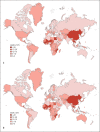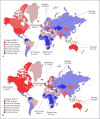The Burden and Trends of Primary Liver Cancer Caused by Specific Etiologies from 1990 to 2017 at the Global, Regional, National, Age, and Sex Level Results from the Global Burden of Disease Study 2017
- PMID: 33083281
- PMCID: PMC7548973
- DOI: 10.1159/000508568
The Burden and Trends of Primary Liver Cancer Caused by Specific Etiologies from 1990 to 2017 at the Global, Regional, National, Age, and Sex Level Results from the Global Burden of Disease Study 2017
Abstract
Background: Liver cancer is one of the leading causes of cancer-related deaths worldwide. The primary causes of liver cancer include hepatitis B virus (HBV), hepatitis C virus (HCV), alcohol consumption, nonalcoholic fatty liver disease, and other factors.
Aims: The objective of this study was to evaluate the global and sex-, age-, region-, country-, and etiology-related liver cancer burden, as well as the trends in liver cancer caused by different etiologies.
Methods: The causes of liver cancer from 1990 to 2017, including global, regional, and national liver cancer incidence, mortality, and etiology, were collected from the Global Burden of Disease study 2017, and the time-dependent change in the trends of liver cancer burden was evaluated by annual percentage change.
Results: The global liver cancer incidence and mortality have been increasing. There were 950,000 newly-diagnosed liver cancer cases and over 800,000 deaths in 2017, which is more than twice the numbers recorded in 1990. HBV and HCV are the major causes of liver cancer. HBV is the major risk factor of liver cancer in Asia, while HCV and alcohol abuse are the major risk factors in the high sociodemographic index and high human development index regions. The mean onset age and incidence of liver cancer with different etiologies have gradually increased in the past 30 years.
Conclusions: The global incidence is still rising and the causes have national, regional, or population specificities. More targeted prevention strategies must be developed for the different etiologic types in order to reduce liver cancer burden.
Keywords: Global Burden of Disease study; Hepatitis B virus; Hepatitis C virus; Hepatocellular carcinoma; Incidence and death.
Copyright © 2020 by S. Karger AG, Basel.
Conflict of interest statement
The authors declare no conflict of interest regarding the content of this paper.
Figures






References
-
- Bray F, Ferlay J, Soerjomataram I, Siegel RL, Torre LA, Jemal A. Global cancer statistics 2018: GLOBOCAN estimates of incidence and mortality worldwide for 36 cancers in 185 countries. CA Cancer J Clin. 2018 Nov;68((6)):394–424. - PubMed
-
- National Cancer Institute Surveillance, Epidemiology, and End Results Program. https://seercancergov/statfacts/html/livibdhtml accessed on 09/2019.
-
- Allemani C, Matsuda T, Di Carlo V, Harewood R, Matz M, Nikšić M, et al. CONCORD Working Group Global surveillance of trends in cancer survival 2000-14 (CONCORD-3): analysis of individual records for 37 513 025 patients diagnosed with one of 18 cancers from 322 population-based registries in 71 countries. Lancet. 2018 Mar;391((10125)):1023–75. - PMC - PubMed
-
- Ascha MS, Hanouneh IA, Lopez R, Tamimi TA, Feldstein AF, Zein NN. The incidence and risk factors of hepatocellular carcinoma in patients with nonalcoholic steatohepatitis. Hepatology. 2010 Jun;51((6)):1972–8. - PubMed
LinkOut - more resources
Full Text Sources
Other Literature Sources
Miscellaneous

